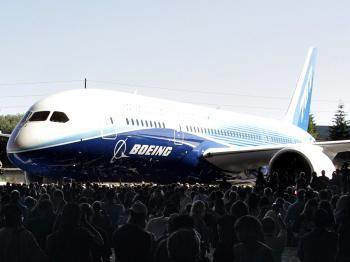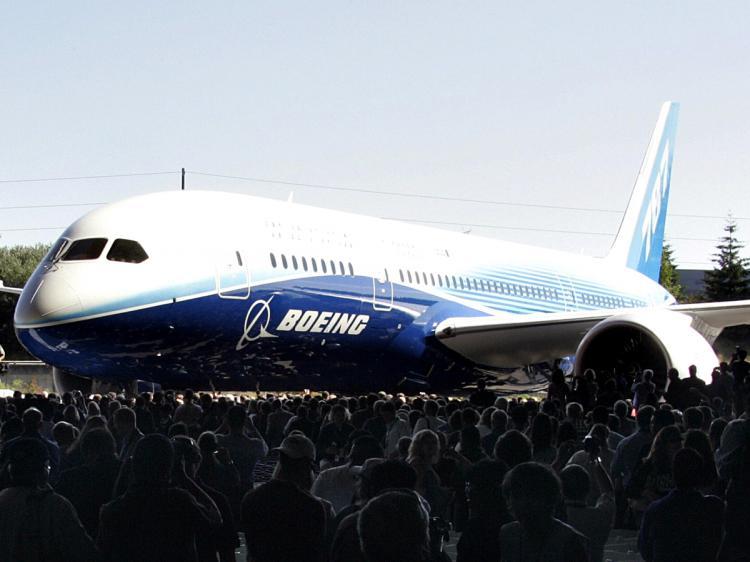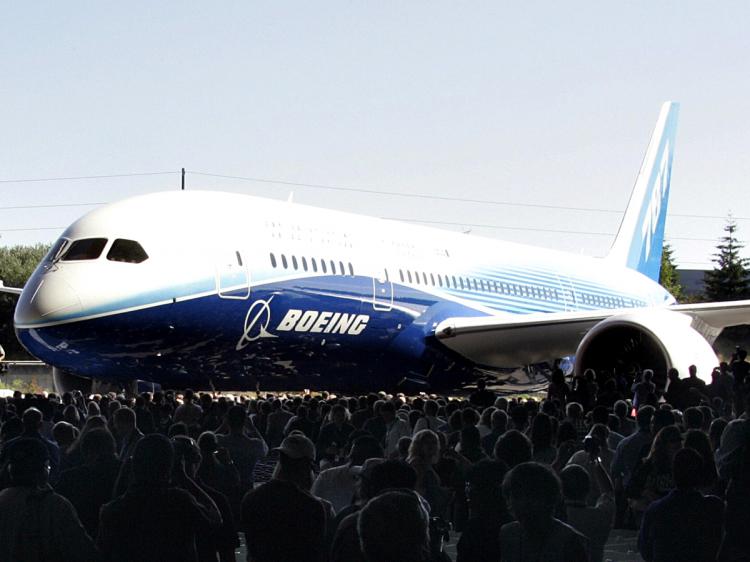Beset by two years worth of setbacks, errors, and general misfortune, Boeing Co. employees will breathe a collective sigh of relief as the Boeing 787 Dreamliner is finally ready for its test flight this week.
Boeing announced that the final flight date would be determined by internal reviews, the weather, and permission from the Federal Aviation Administration. The next-generation Dreamliner a mid-sized commercial jet boasts a quieter ride, lower emissions, and will use less fuel due to lighter materials.
Last Thursday, Chicago-based Boeing conducted final review and analysis of the static test from last month, and completed the final gauntlet-testing on the test aircraft, signaling that the plane is ready for take off.
“I am happy to report that the program has validated the airplane structure for the 787 Dreamliner,” said Scott Fancher, vice president and general manager of the 787 program.
The static test, which tests the structural soundness of the wings, was necessitated by an earlier discovery of several weak points where the Dreamliner’s wings connected to the fuselage.
Delays and Errors
Boeing revolutionized its aircraft assembly with the 787—albeit laden with errors and delays.
For the first time in company history, Boeing abandoned its approach of receiving individual parts and assembling the aircraft at its Everett, Wash. plant. Instead, the company hired subcontractors to do more work and then ship the sub-components to Boeing.
This required a great deal of expertise on the subcontractors’ part, as well as close monitoring and quality assurance by Boeing managers and engineers. The change in production led to delays, as some subcontractors were unable to complete their work on time.
Boeing originally planned a maiden flight more than two years ago, in September 2007. In earlier September 2007 Boeing announced a six-month delay on its test flight and a six-month delay on delivery date.
Soon thereafter, the company announced additional delays, and production was further hampered by the Boeing machinists strike in late 2008. In November 2008 Boeing reported an additional delay due to incorrect installations of certain fasteners by its suppliers.
In June 2009 at the Paris Air Show, Boeing said that a test flight for the Dreamliner would begin in two weeks. However, several days later the company issued a press statement regarding the needed to reinforce the sides of the aircraft,” and the maiden flight would be delayed indefinitely until the issue is resolved.
By November, it appeared that the fuselage issue was fixed by Boeing, and the Dreamliner’s test flight would finally commence in December.
Technological Innovation
When Boeing engineers conjured up the idea of a new jetliner in 2002 code-named the 7E7, few pundits were impressed.
Airbus, the company’s European-based rival, was thumping its chest over the A380, a super-jumbo aircraft that promised to transform commercial aviation. Many analysts salivated over the A380’s size and grandeur—which could usher in a new era of globetrotting. It would later become the largest commercial aircraft ever assembled.
But Boeing’s concept—later materialized as the 787 Dreamliner—was pedestrian compared to Airbus’s vision. The 7E7 concept was a fuel-sipping, super-efficient medium-sized wide-body airliner that would save airlines money in the long run.
But Boeing proved its doubters wrong. As petroleum prices skyrocketed and many airlines rushed to slash costs, the 787 became a top seller.
The 787 forgoes traditional aluminum for lighter composite materials—including carbon fiber-reinforced plastic—to save fuel. Such promises of fuel efficiency made the aircraft the fastest selling in aviation history.
According to the company, 50 percent of the 787’s materials are composite. Aluminum and titanium consist of only 20 and 15 percent, respectively.
Customers Line Up
Today, Boeing has 840 orders (net of cancellations) from airlines around the world, with Japan’s All Nippon Airways as its launch customer.
Many airlines have signed up due to the aircraft’s fuel efficiency. “[The 787] will provide major environmental improvements in terms of global emissions, local air quality and noise. With lower operating costs and the range to fly to all our destinations, it will give us more flexibility,” British Airways CEO Willie Walsh said in a statement on Boeing’s Web site.
All Nippon leads all airlines with 55 firm orders for the aircraft, followed by Air Canada with orders for 50 jets.
Last week, United Airlines placed an order of 25 Dreamliners with an arrangement for future purchases of up to 50 more aircraft units.
First deliveries of the 787 Dreamliner to All Nippon will occur in late 2010.
Boeing announced that the final flight date would be determined by internal reviews, the weather, and permission from the Federal Aviation Administration. The next-generation Dreamliner a mid-sized commercial jet boasts a quieter ride, lower emissions, and will use less fuel due to lighter materials.
Last Thursday, Chicago-based Boeing conducted final review and analysis of the static test from last month, and completed the final gauntlet-testing on the test aircraft, signaling that the plane is ready for take off.
“I am happy to report that the program has validated the airplane structure for the 787 Dreamliner,” said Scott Fancher, vice president and general manager of the 787 program.
The static test, which tests the structural soundness of the wings, was necessitated by an earlier discovery of several weak points where the Dreamliner’s wings connected to the fuselage.
Delays and Errors
Boeing revolutionized its aircraft assembly with the 787—albeit laden with errors and delays.For the first time in company history, Boeing abandoned its approach of receiving individual parts and assembling the aircraft at its Everett, Wash. plant. Instead, the company hired subcontractors to do more work and then ship the sub-components to Boeing.
This required a great deal of expertise on the subcontractors’ part, as well as close monitoring and quality assurance by Boeing managers and engineers. The change in production led to delays, as some subcontractors were unable to complete their work on time.
Boeing originally planned a maiden flight more than two years ago, in September 2007. In earlier September 2007 Boeing announced a six-month delay on its test flight and a six-month delay on delivery date.
Soon thereafter, the company announced additional delays, and production was further hampered by the Boeing machinists strike in late 2008. In November 2008 Boeing reported an additional delay due to incorrect installations of certain fasteners by its suppliers.
In June 2009 at the Paris Air Show, Boeing said that a test flight for the Dreamliner would begin in two weeks. However, several days later the company issued a press statement regarding the needed to reinforce the sides of the aircraft,” and the maiden flight would be delayed indefinitely until the issue is resolved.
By November, it appeared that the fuselage issue was fixed by Boeing, and the Dreamliner’s test flight would finally commence in December.
Technological Innovation
When Boeing engineers conjured up the idea of a new jetliner in 2002 code-named the 7E7, few pundits were impressed.Airbus, the company’s European-based rival, was thumping its chest over the A380, a super-jumbo aircraft that promised to transform commercial aviation. Many analysts salivated over the A380’s size and grandeur—which could usher in a new era of globetrotting. It would later become the largest commercial aircraft ever assembled.
But Boeing’s concept—later materialized as the 787 Dreamliner—was pedestrian compared to Airbus’s vision. The 7E7 concept was a fuel-sipping, super-efficient medium-sized wide-body airliner that would save airlines money in the long run.
But Boeing proved its doubters wrong. As petroleum prices skyrocketed and many airlines rushed to slash costs, the 787 became a top seller.
The 787 forgoes traditional aluminum for lighter composite materials—including carbon fiber-reinforced plastic—to save fuel. Such promises of fuel efficiency made the aircraft the fastest selling in aviation history.
According to the company, 50 percent of the 787’s materials are composite. Aluminum and titanium consist of only 20 and 15 percent, respectively.
Customers Line Up
Today, Boeing has 840 orders (net of cancellations) from airlines around the world, with Japan’s All Nippon Airways as its launch customer.Many airlines have signed up due to the aircraft’s fuel efficiency. “[The 787] will provide major environmental improvements in terms of global emissions, local air quality and noise. With lower operating costs and the range to fly to all our destinations, it will give us more flexibility,” British Airways CEO Willie Walsh said in a statement on Boeing’s Web site.
All Nippon leads all airlines with 55 firm orders for the aircraft, followed by Air Canada with orders for 50 jets.
Last week, United Airlines placed an order of 25 Dreamliners with an arrangement for future purchases of up to 50 more aircraft units.
First deliveries of the 787 Dreamliner to All Nippon will occur in late 2010.






